In our latest look into the history of archery, we examine how our medieval ancestors once carried the essentials.
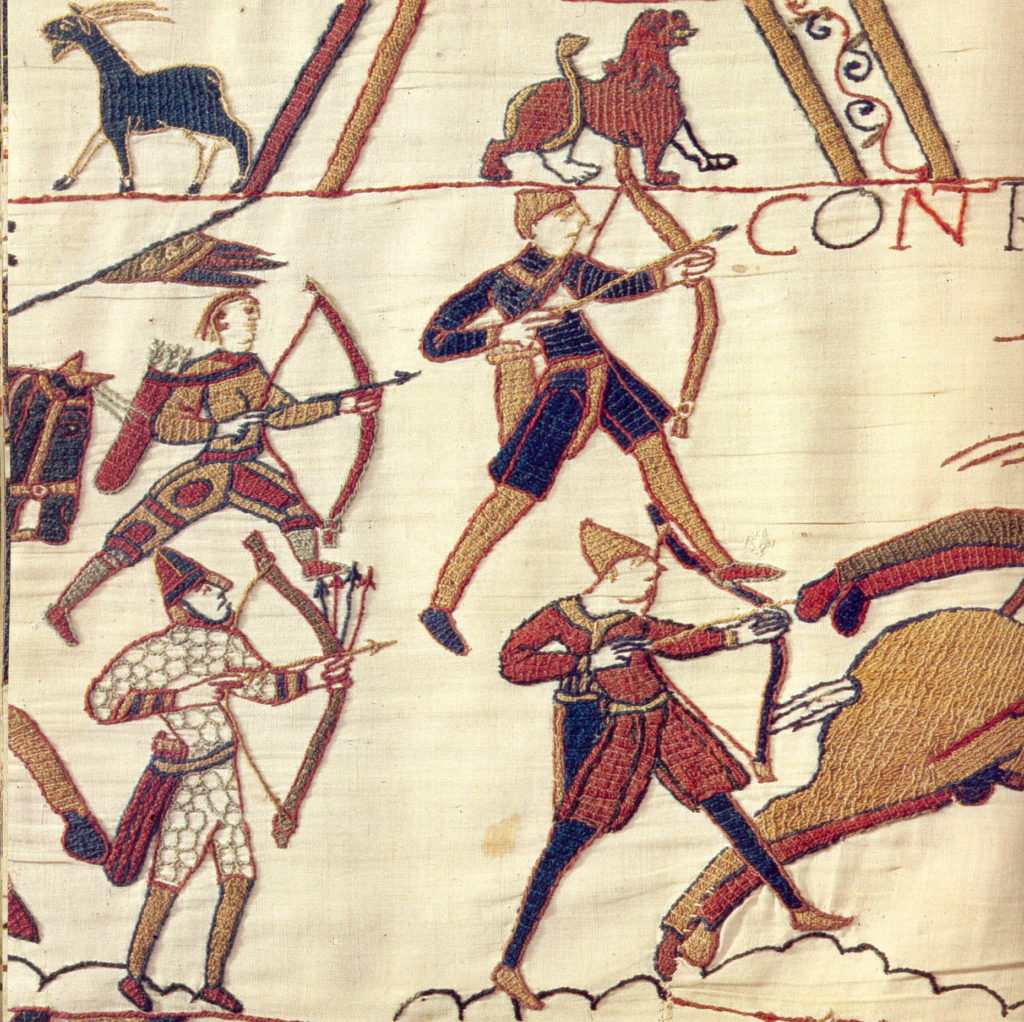
Achery and Hollywood – not often a great combination. Particularly when it comes to quivers, film-makers can’t seem to resist the urge to place them on the actors’ backs, where the arrows will rattle, be prone to falling out or getting caught in overhanging trees, and have to be pulled out blindly over the shoulder in a long and cumbersome motion.
Ever since Errol Flynn’s ’Robin Hood’ (1938), the leather back quiver appears to have been a favourite accoutrement for ’medieval archers’ in film and television. However, there is absolutely no historical evidence for its use in Europe during the Middle Ages.
Most probably, real medieval archers were well aware of the disadvantages of carrying their precious arrows on their back and thus out of sight. A variety of means to transport arrows were used instead.
However, since these containers were invariably made of organic materials such as wood, leather, or fabric, only few specimens or fragments have survived. A few remains from the Iron Age migration period, and early medieval graves offer clues as to the shape, construction, and ways of carrying these quivers.
Many of them were of Eastern origin, introduced by the invading Huns and Avars. They resemble long conical tubes of oval cross section made of birch bark or leather covered wood, usually equipped with a lid or flap. Arrows were inserted with their tips up, so that specific arrowheads could be chosen, and the sensitive fletchings were well protected. They were carried on belts, attached by metal rings and hooks, on the right side of the hip.
While the English word ’quiver’ derives from the Old French quivre, cuevre or coivre, the German term ’köcher’ can be traced back to the Turko-Mongolian word kukur, which became cucura in Latin, thus betraying its Eastern origin.
A very simple form of quiver has probably been in use at least since the Iron Age. It is in the shape of a round tube with a bulging upper rim, mostly made from leather, and worn on the right hand side with a shoulder strap. Arrows were inserted with their heads down, the fletchings protruding over their entire length above the upper opening.
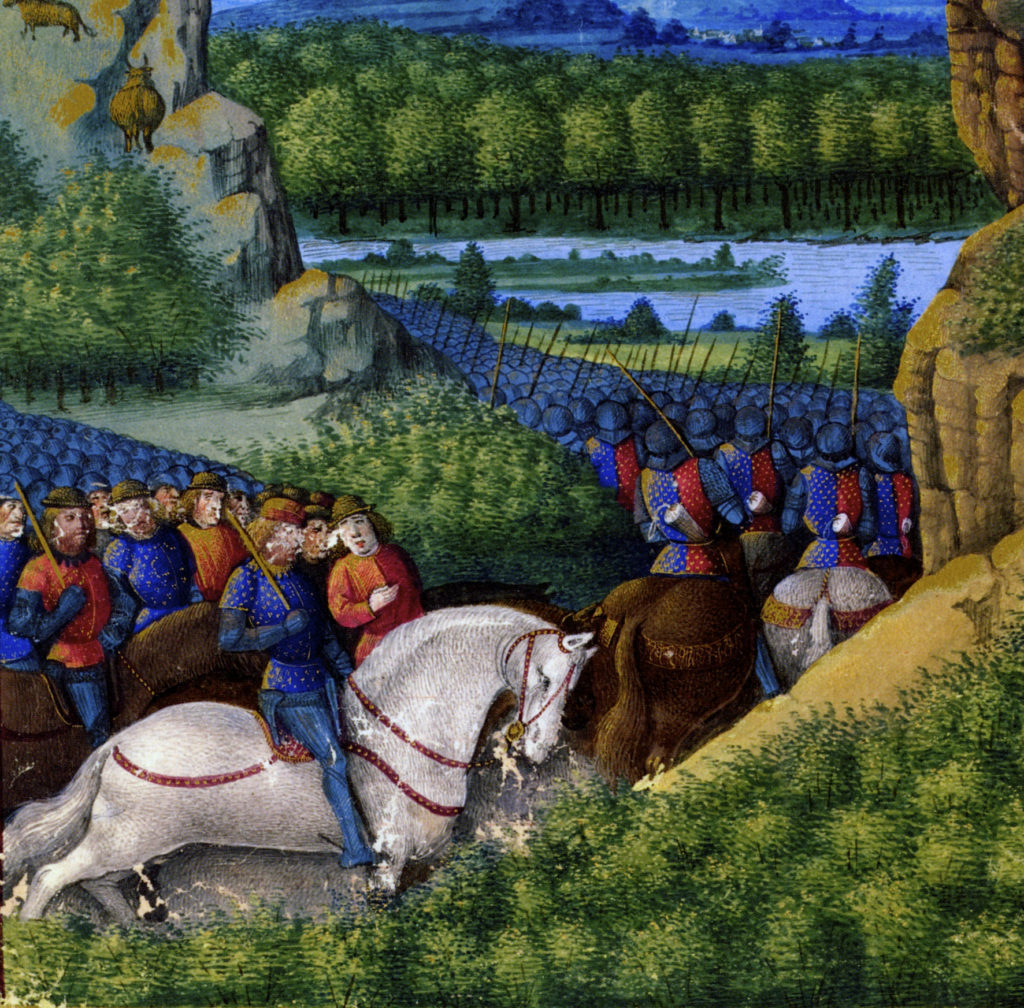
Quivers of this description are worn by the Norman archers depicted on the Bayeux Tapestry, created around 1070 AD. They may well have been the standard model of the low-ranking infantry archer, while the more sophisticated Eastern type has been found mostly in well equipped burials of the Merovingian period.
Fragments of leather quivers have also been found in archaeological digs at the Viking age settlement Haithabu (Hedeby) in today’s Northern Germany. Their total length was only 62 cm (not quite 25“), of slightly conical shape, with a diameter of 9 cm (3 ½“) at the top. The bulging rim at the opening was fringed, and in the upper third of the tube two triangular pieces of leather with oval slits were attached, probably in order to insert a shoulder strap.
As far as they can be interpreted as realistic representations at all, the quivers in the Utrecht Psalter (ca. 820–835 AD) appear like a mix of central Asian and central European traditions. Carried with shoulder straps, the long tubes of unknown material seem to have a dome-shaped lid, and the arrows are shown with their heads upwards. But since the illustrator indiscriminately mixed contemporary, antique, and Byzantine motifs throughout his work, perhaps these quivers should not be considered accurate depictions of Carolingian means of arrow transport.
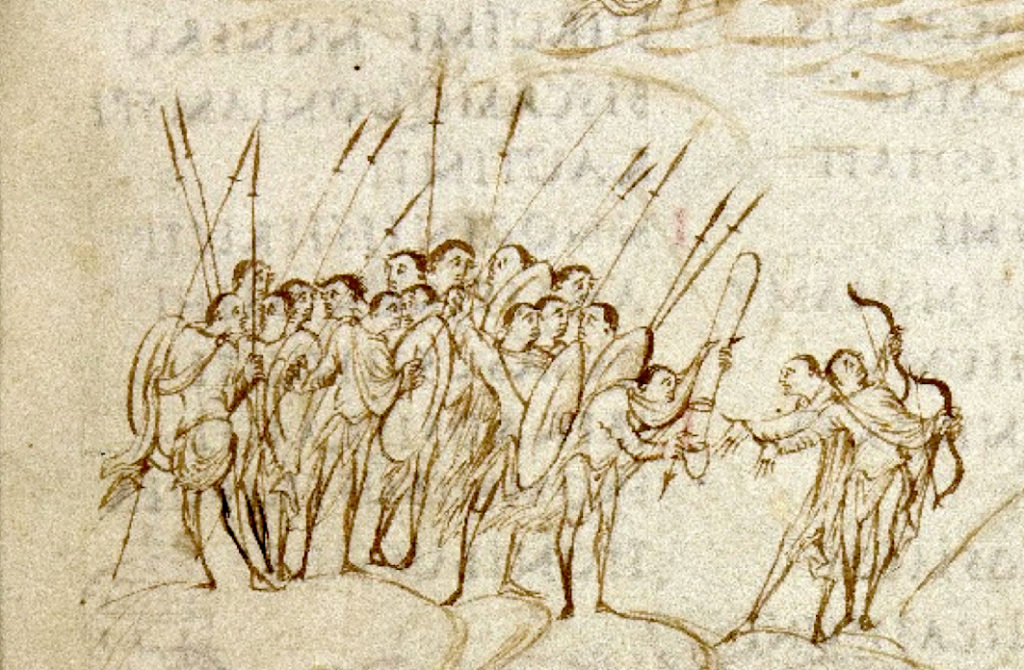
In his Capitulare Aquisgranense of 802 AD, Charlemagne decreed that every Frankish warrior in the array has to posses not only lance and shield, but also a bow with two strings and at least a dozen arrows. Although not explicitly stated, it can be assumed that this personal contingent was to be carried in some form of container. A few years earlier, the Capitulare de villis mentions baggage carts to accompany the host and to transport, among other items, bows and quivers (cucurum).
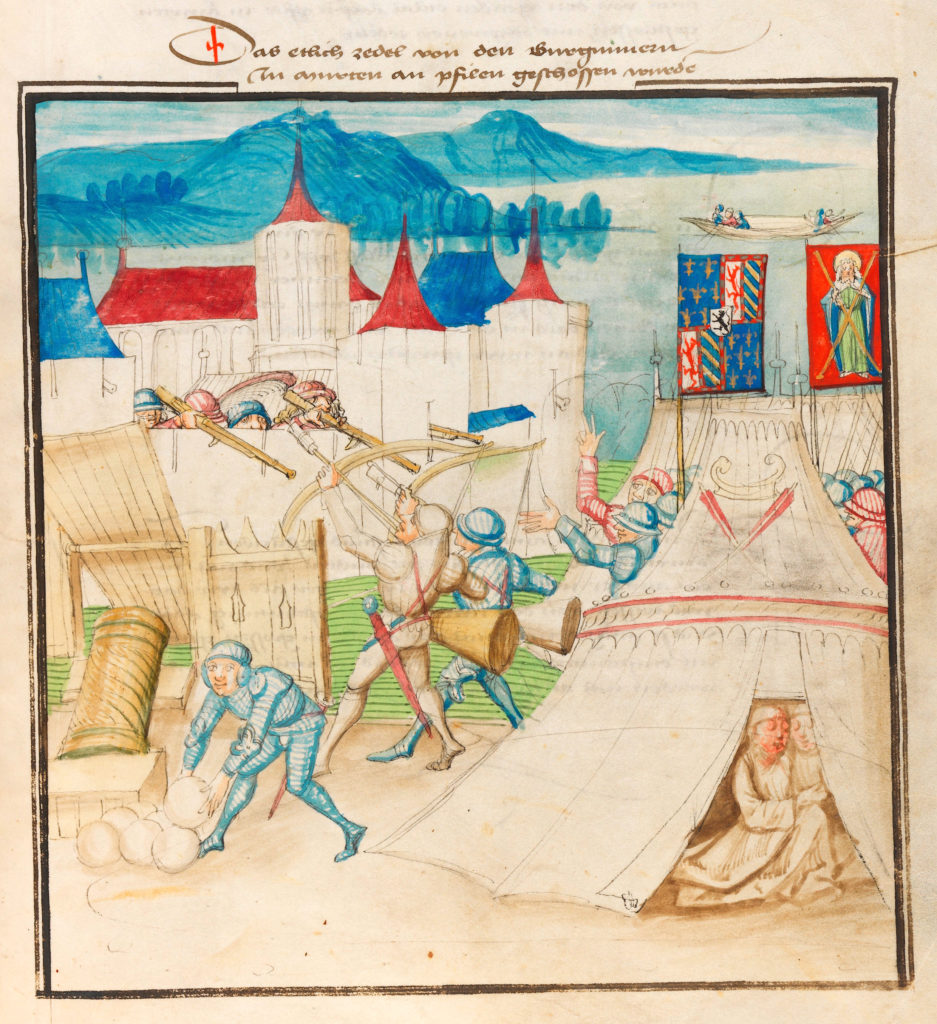
It is known from later sources that large numbers of arrows were stored and transported in boxes and barrels. From notes of Henry VIII in 1513 we learn that 26 carts were needed to transport 240,000 arrows. If it is true that Edward III brought between one and two million arrows for his 7,500 archers at Crécy in 1346, then in order to transport these alone a convoy of up to 200 carts would have been necessary.
Comparatively few depictions of quivers exist from the High Middle Ages, c. 1050-1250 AD. The trusty old leather tube with shoulder strap can still be found, other shapes appear like European adaptions of models used mainly by Central Asian horseback archers.
Of oval or rectangular profile, they flare out at the bottom and appear solid, as if made from a wooden core with leather or fur covering. Some example also widen towards the opening at the top, giving it an hour-glass shape, and they are shown with or without lids.
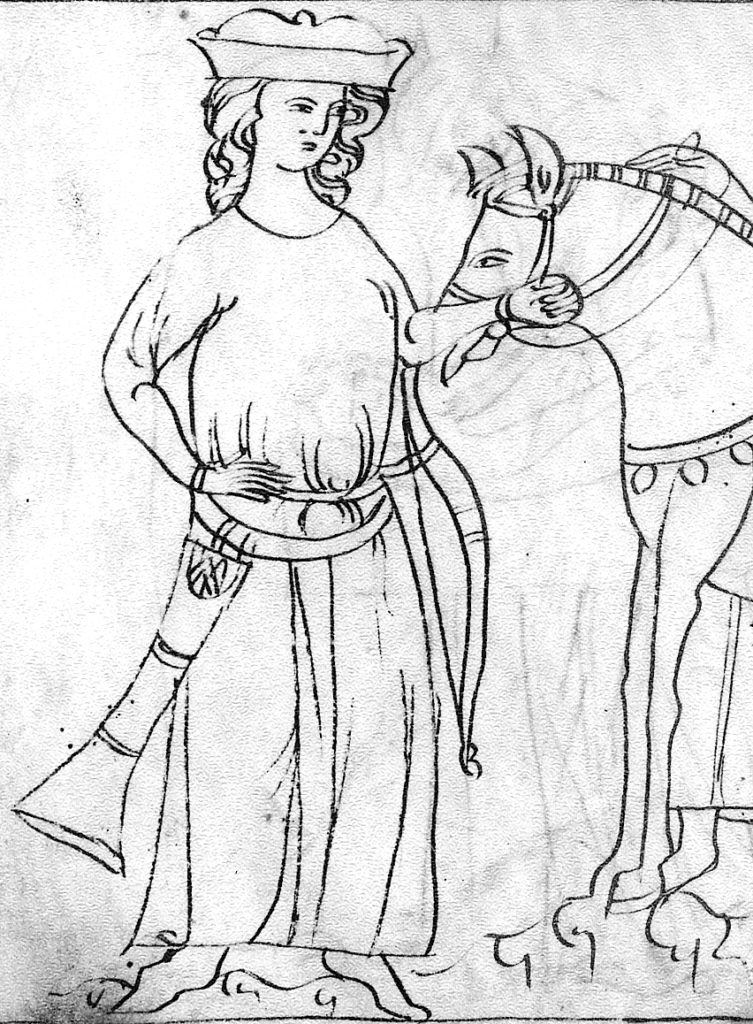
Such quivers were invariably attached to a belt, not a shoulder strap, and worn on the (usually right) hip. Arrows were inserted with their heads up, as was customary in Eastern Europe and Central Asia, and also the case with crossbow bolts, which were often carried in similar, albeit smaller quivers.
Military archers were generally of lower social standing and hence not often depicted, let alone accurately, in High Medieval illustrations. The nobility used the bow mainly as a hunting weapon, but quivers are a rare occurrence in hunting scenes of the period. Most likely the noble hunters either had their arrows handed to them by a servant, or they simply carried them in their belt.
This practice is well documented in contemporary illustrations and well-known texts such as Roger Ascham’s ’Toxophilus’ (1545), who quotes a popular saying that every English archer carried the lives of 24 Scots under his belt – referring to the number of arrows, a sheaf, issued to every longbowman of the time.
While it is easy to transport a small number of shafts this way, a bundle of two dozen means the belt would have to be tightened every few shots, or else the remaining arrows would simply slip out. Inventories of the 16th century mentions special leather straps to wrap around the bundle, tie with knots, and attach to the belt proper. Experimenting with this, John and Jonathan Waller found it worked best with a marlin hitch or a millers knot, which could easily be re-tightened with a light tug of the thumb after pulling out an arrow.
Late Medieval illustrations show two variations of this practice: If the arrows are worn horizontally behind the archer’s back, they don’t take up much space, but have to be pulled by the nock which only works with slim arrowheads without barbs. Carried at the right hip, with fletchings to the rear and tips pointing slightly downwards, they can be pulled forward comfortably by their heads.
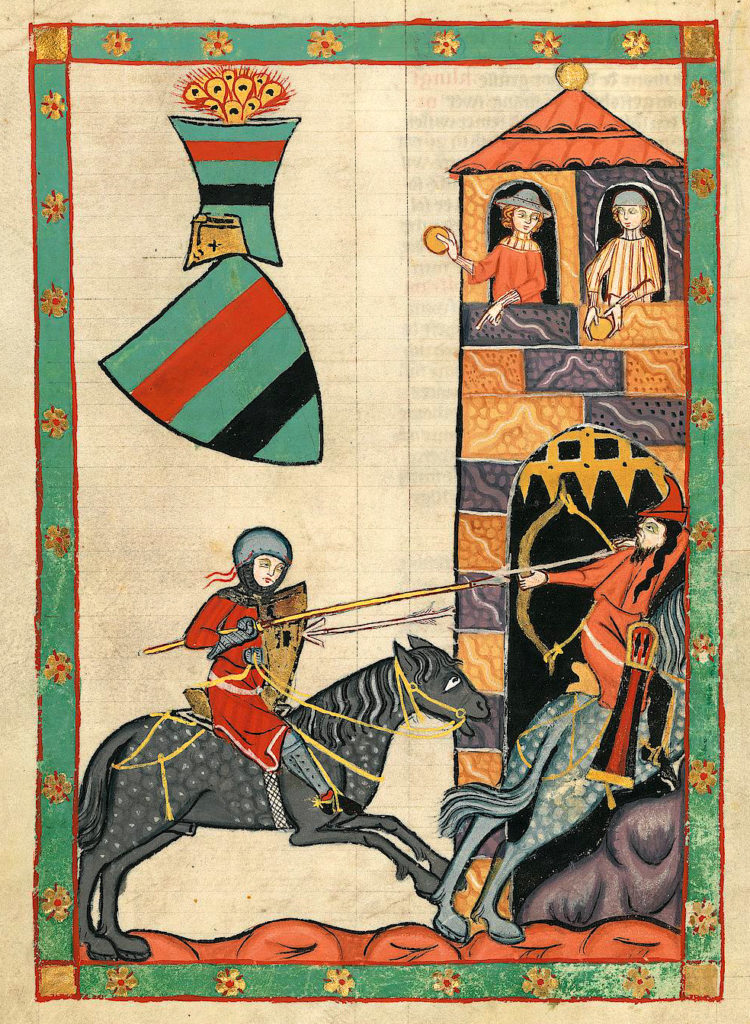
A certain form of arrow bag may have been ’standard issue’ for English military archers in the Late Middle Ages and Renaissance. It is not often depicted in contemporary illustrations, but evident from archaeological finds: Seventeen circular leather discs, each with exactly 24 hole of ½“ diameter were found aboard the Mary Rose sunk in 1545. Fragments of arrow shafts still sticking through some of these holes left no doubt as to their use.
A drawing in a 1777 notebook now kept in the Bodleian Library reveals further details of the constructions of these arrow bags. The leather ’spacers’ were sewn in approximately at the centre of a linen hose ’the size of a stocking’. Its lower opening was tied with a piece of string, the bottom stuffed with hay or straw to prevent damage from the pointy arrowheads. A loose leather covering protected the fletchings from moisture, probably was also secured with a string or leather strap.
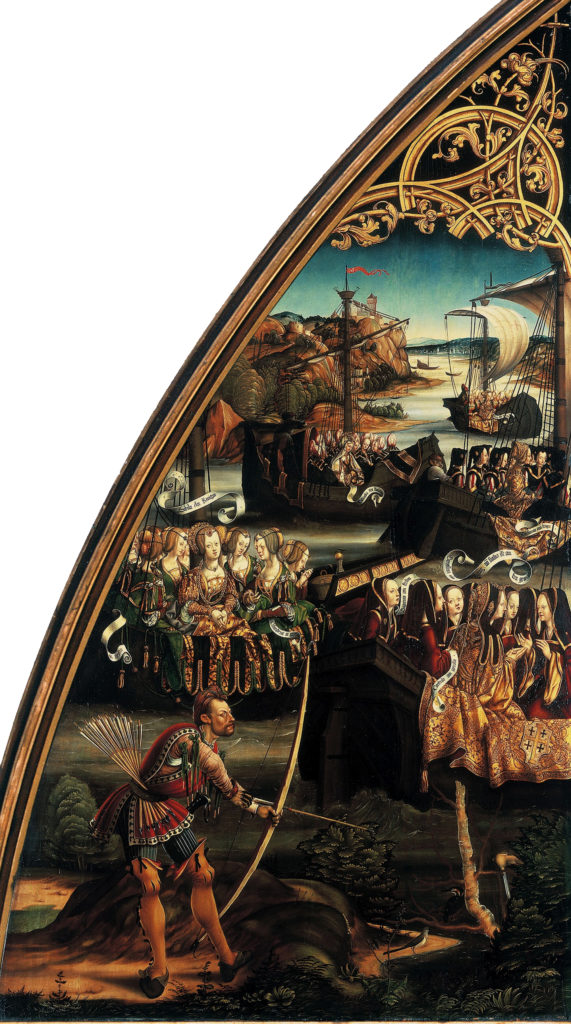
Thin leather straps, also found aboard the Mary Rose, were probably used to attach the arrow bag to the archer’s belt. A rare 15th century illustration shows mounted archers on crusade with closed arrow bags tucked under their belts. The archers on the Cowdray Engravings (based on a lost 16th century painting) appear to carry arrow bags of similar construction – albeit on the left side, while the sword is on the right, which would be a very unusual and unpractical arrangement for right-handed archers.
A coloured drawing in Diebold Schilling’s Berne Chronicles depicts two English archers in service of Charles the Bold of Burgundy shooting message arrows over a town wall. The weird looking conical objects on their belts are probably meant to be somewhat oversized linen arrow bags.
In another scene, a similar container is shown next to a dead archer, with arrow fletchings protruding. Since these ’bags’ never seem to lose their conical shape, Clive Bartlett suggested they might be of wicker construction with a linen cover.
While the bow went out of fashion as a weapon of war in the 15th and 16th centuries, it was still used for hunting and sport. Renaissance illustrations suggest that the simple leather tube, worn either on the belt or with a shoulder strap, remained the most common form of arrow transport, while new, fashionable shapes of Turkish and Oriental origin also made their appearance.
Still, regardless of all variations and alterations in shape, construction, decorations, and carrying styles, one aspect remained unchanged over the centuries: there was not a single back quiver in sight!


Great article. Thanks fur the research
Hello! I am a reenactor who does leatherwork and would love the bibliography citations for this article. Where can I find this?
I’d loved a bibliography as well
Hi everyone, thanks for the kind words! Sorry, since I wasn’t the one to upload this, I didn’t learn about your comments until now.
I’m afraid I used mostly German sources, since this article was originally published in a German magazine. But here’s my list, I especially recommend the article by the Wallers:
• Clive Bartlett: English Longbowman 1330-1515, Botley 1995.
• Mike Loades: The Longbow, Botley 2014.
• Holger Riesch: Historische Pfeilköcher in Mitteleuropa. Römische Kaiserzeit bis zum Ende des frühen Mittelalters, in: Karfunkel 46 (2003), pp. 30-35.
• dito: Pfeilköcher in Europa. Vom hohen Mittelalter bis zur Renaissance, in: Karfunkel 50 (2004), pp. 93-99.
• Jonathan und John Waller: The Personal Carriage of Arrows from Hastings to the Mary Rose, in: Arms & Armour 7,2 (2010), pp. 155-177. (Online: https://doi.org/10.1179/174161210X12810012151357)
If you’re interested in the Mary Rose quivers there are instructive videos on YT by Nick Birmingham (BigBowBrum).
You spend this whole article claiming there are absolutely no depictions of back quivers in medieval Europe yet the very first picture you show of the Bayeux tapestry depicts an archer with his quiver slung across his back at the top left…. Come on… I understand saying historical precedence for back quivers are limited and that hip quivers were likely far more common. But you can’t say the depictions absolutely don’t exist and ignore the fact that you just showed one of the depictions.
The quiver i question is the same as all the others depicted in the Bayeux Tapestry, i.e. an open leather tube with a single leather strap that can be worn on the hip (as in all the other instances) or over the shoulder, as in this particular case.
The fact that it is (temporarily) worn more or less on the back does not make it a back quiver, much like wearing a backpack on your chest does not make it a frontpack 😉
Does it not though? I’m not arguing that if they did exist that they weren’t a major minority and that historical evidence is vastly limited and ALMOST non-existent as far as medieval europe goes. I’m just saying that we shouldn’t say there is ABSOLUTELY no historical precedence for them when we do have a depiction of one who is not only wearing a quiver slung over his shoulder and/or back and seems to be actively firing. And it seemed an important enough detail to be included by the artist. Could it be imbelishment? Yeah. Could it be a traveling position? Sure, but we can’t say for sure and it’s enough to sway us from speaking in absolutes. Especially when you consider that back quivers showed up in other cultures and modern archers have shown that there are use cases for wearing a quiver on your back, even if it’s a niche use. We have a similar thing in HEMA about blocking with edge or flat. People tend to camp on one and say the other is useless, when there is historic evidence for both and in reality, it depends on the individual and circumstance.
I have a link here to WordPress that might be of interest…
https://broadarrow773978019.wordpress.com/2022/10/11/warbow/
In the earliest publication on archery “L’art de archerie” in 1515 Henri Gallice tells us how to draw a long arrow (36″) from it’s quiver on the right side.. https://www.archerylibrary.com/books/gallice/
In the newly published Tower inventory and Henri Gallice we now know that 36″ war arrows were not whipped just glued and the heads were push fit not pinned or bound so as to come apart if removed from shields or flesh. The arrowheads of Crecy were made of steel and star tipped which as far as I can ascertain is the fluted bodkin. (cum capitibus asteratis).